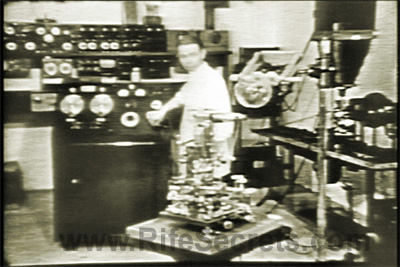
The history of Royal Raymond Rife and his Rife Machines gets rather complicated and controversial. It's clouded in both the mystery of a history clouded by the profit motives of pharma which sought to hide it and the complicated nature of a technology which was far ahead of its time.
In this series of posts, you'll get a glimpse into the truth about what he really accomplished.

Here in part one, I'll be discussing power levels which were used historically and the importance of getting enough power in order to replicate the type of results that were achieved historically.
The first question that comes up quite commonly when power levels are considering is whether harm can be done with this technology and these frequencies?
When addressing this question it's important to consider both the frequencies being used as well as the power levels. The frequencies that Rife used were in the low RF spectrum between 200,000 Hz and 1,608,000 Hz. This crossed right over the AM broadcast band to put this in perspective. These frequencies are also much lower than the frequencies used in telecommunications. Wireless telecommunications uses frequencies starting around 900,000,000 Hz (900 MHz) and commonly up in the range of 1.8-2.4 GHz. These are much higher frequencies than what Rife used.
The big debate over the potential harm from telecommunication frequencies relates to the potential to harm the body without a heating effect. These potential "non-thermal" effects which have been demonstrated in numerous studies which I would attempt to cite here but that's not the point of this post. Interestingly, it is of my personal opinion that the effects that Rife achieved with "resonance" are actually related to the idea of "non-thermal" effects. Essentially what I'm getting at here is that Rife was able to achieve effects at relatively low power levels, lower than what it actually takes to heat the tissue.

With that in mind it's important to keep a few things in mind; even though the power level is low enough that it may not heat the tissue it's still dependent on power and there is a physiological effect happening in the tissue. This is in contrast to a technology like radionics which got a bad name historically and has been rebranded as "remote healing" in recent years. While this isn't to say that there's no basis for a radionics effect, it's not what Rife was doing and for Rife's method to work, it required higher power levels than radionics does.
Getting back to the safety of this technology let's look at some of what Rife said about this:
RIFE: “I stood in front of that thing for thirty years finding these different frequencies that devitalize these different bacteria. And that thing [RF ray tube] was shooting on me right here [his chest], but it is absolutely harmless to normal tissue and each individual bacteria requiring a different frequency to devitalize.” from John Marsh CD mastered by rifevideos.com
Historically there is some confusion about the power levels that were actually used. Part of this is likely because there are various ways of measuring the power output. The most accurate method of measurement is called "RMS Power" or root mean squared. Don't worry I'm not going to get too technical here but suffice it to say that it's basically the "average" power.
Part of the confusion that seems to have come up is that some have confused power consumption of the generator with power output. Frequency generators are not 100% efficient so it might require 300 watts of power from the wall to generate say 100 watts of output power. That's still a 100-watt generator!
Rife's original equipment from the 1930's (the generators that built his reputation since they worked so well) consumed 400 to 600 watts of power to run but the output power on the plasma tube varied from about 50 to 400 watts. This is still a significant amount of power.
Why did they need so much power?
Part of the reason is the plasma tube (sometimes called "ray tube") method uses what's called "Plasma Induction". This means that it induces power using a field effect. Essentially this means that anything within the plasma field absorbs a certain percentage of the power from the field. Because only a certain percentage of the power is induced more power is needed for plasma induction to work effectively.
The other important factor to consider regarding power output in these machines is the waveform.



In the first few lab machines (Rife Ray #1,#2,#3, and #4) a damped waveform was used (see image above). With a damped wave actually makes the RMS (think average) plasma output only about 11% of the full output power! This is significant because in the production model (referred to as the "Beam Ray Clinical" machine) that was then developed by Rife's electrical engineer Philip Hoyland he instead used a wave that in today's terms can best be described as a square wave (see image below).

The advantage of the "square wave" (in quotes because it wasn't exactly the type of square wave that was eventually used in digital electronics, but it's essentially the same thing) was that it had the potential to drive 100% of the power of the generator into the plasma tube output. This still isn't 100% efficient use of power from the outlet but it made the plasma output much more efficient at driving results.
It's also important to understand that while power levels fluctuated in the various machines as the development progressed the overall useful power was on an upward trend. The Beam Ray Clinical machine had an RMS power output of 75 watts (reduced from 400 technically) but since the new waveform was much more efficient this was actually more power output (Rife Ray #4 at 400 watts x 11% efficiency damped waveform = 44 Watts RMS power).
When it comes to modern machines there's a lot of factors to consider regarding power output but generally speaking, many of the systems out there are actually quite underpowered when you consider all these factors.
Unfortunately, frequency range and RF carriers (which will be discussed in Part 2 of this series of reports) bring in a whole new variable regarding power. The reason I say it this way is that a lot of the modern generators out there are not modeled after the historical machines at all and can't even run the original frequency range that was used in the 1930's!
When running lower frequencies pulsed on a plasma tube output (yes this is actually very common) the effect is actually more like a pulsating magnetic effect. Essentially the "pulse" of a waveform such as what's shown above simply pulses the plasma tube much in the way that it would pulse a coil of wire. In this way, it creates more of a pulsating magnetic effect with the tube rather than an RF antenna broadcasting effect which the higher frequencies deliver.
Pulsed magnetic fields are measured differently with gauss field strength measurements rather than RMS watts so it's important to know which type of machine you are using when thinking about "power" output.
In Part 2 we'll get much deeper into frequencies so keep an eye out for that coming soon. The best way to get updates and know when it's posted is to be a confirmed email subscriber and you'll be the first to know when important new posts and videos go live.
Please share your comments and feedback below so we can make this series even better with your input. Also, if you found this helpful go ahead and share it with your friends wherever you like to do that sort of thing.







Is the BCX ULTRA 2 have enough power? Are you allowed to recommend any particular machine?
If so, which one or ones? I await your reply. Thank you1
Joshua, very interesting article. can you imagine the social ramifications that would result if an individual was to discover a frequency that would reset the biological clock to youth and then clandestinely smuggle such equipment into a nursing home? I have such thoughts (and similar thoughts) about disrupting the biological timing of the existing social order every day. this is my #1 obsession. I am having so much FUN. I apply my ideas to this purpose at every opportunity.
Ive read the Rife Story. I find this topic very interesting indeed.
Keep it coming.
Thanks much.
Tony
Is the Rife Machine effective against Osteoarthritis of the Hip and Knees? I have just started looking into Rife's work and if it is effective on Osteoarthritis I will be delving into this more.
Thanks
Dave
Hi Dave,
Some people do report positive results with this but I'm not a doctor so I tend to avoid answering with extremely positive results especially considering I don't know anything about your particular condition.
My experience has been that the electromagnetic technologies have been helpful for just about everything but different tools for different things depending on what it is.
-Joshua
Is a version of his invention available for purchase online? Is the sound enough to heal a room full of people, or is it required to be attached to a person?
Thanks Bob,
Please contact me using the live chat on this site so we can talk about the machine. Regarding the "room full of people" I personally prefer to point the tube at a specific area of my body and have it close so I get the most amount of power. Historically it was never used on a room full of people, that notion was started in the 1990's but may not have worked very well.
-Joshua